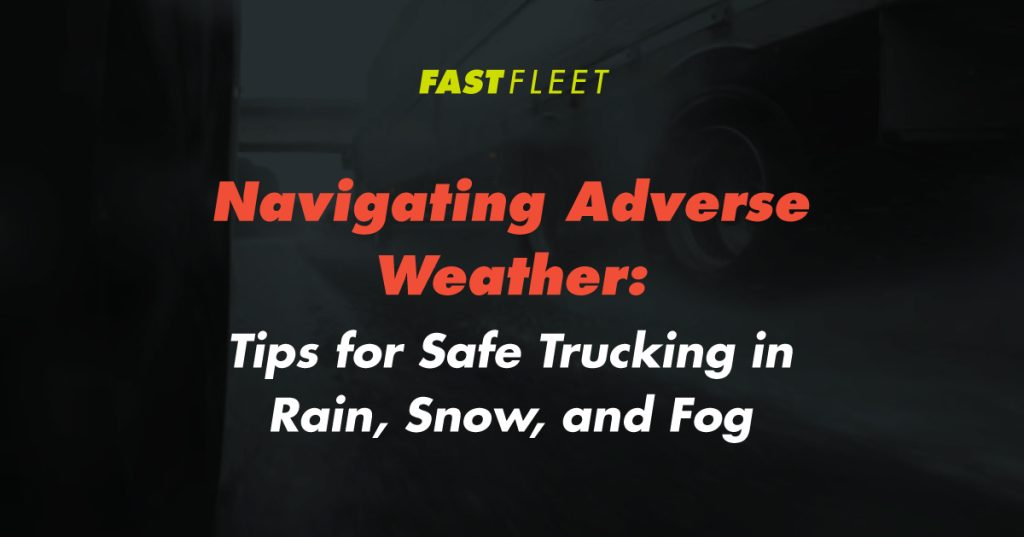Navigating Adverse Weather: Tips for Safe Trucking in Rain, Snow, and Fog
Adverse weather conditions can pose significant challenges for truck drivers. Rain, snow, and fog can reduce visibility, create slippery roads, and increase the risk of accidents.
To ensure safe trucking in adverse weather, drivers must be prepared and equipped with the right knowledge and strategies. In this guide, we’ll provide essential tips for truckers to navigate rain, snow, and fog safely.
Trucking in Rain
Driving a heavy truck in the rain requires extra caution and attention to road conditions.
- Maintain a Safe Following Distance: On wet roads, stopping distances increase significantly. A general rule of thumb is the “3-second rule.”
Choose a fixed point on the road, like a sign or a tree, and when the vehicle in front of you passes it, start counting. If it takes less than three seconds for you to reach that point, increase your following distance. In heavy rain, consider doubling this to 6 seconds.
Imagine you’re driving in moderate rain, and the car in front of you passes a road sign. If you reach that sign in less than three seconds, you’re following too closely. Back off to ensure you have enough room to stop safely.
- Reduce Speed: Slowing down is crucial when roads are wet. Reducing your speed allows for better control and reaction time in case of sudden obstacles or emergencies. Consider driving at or below the posted speed limit during heavy rain.
If the speed limit is 65 mph on a highway, and it’s raining heavily, reducing your speed to 55 or even 50 mph can provide a significant safety margin.
- Avoid Sudden Maneuvers: Quick and abrupt actions like sharp turns, lane changes, or sudden braking can lead to loss of control on wet roads. Make gradual, smooth maneuvers to maintain stability.
If you need to change lanes, use your turn signal early, check your mirrors, and smoothly merge into the next lane. Avoid sudden swerves.
- Properly Functioning Wipers and Defrosters: Good visibility is essential in the rain. Ensure your windshield wipers are in good condition and replace them if they streak or leave streaks. Also, use your vehicle’s defrosters to prevent fogging on the windshield.
Regularly inspect your wiper blades. If they are cracked or torn, replace them promptly. During rain, if your windshield fogs up, turn on the defroster to maintain clear visibility.
Safe Braking in Rain
- Allow for Extended Braking Distances: In wet conditions, it takes longer for your vehicle to come to a complete stop. When following another vehicle, increase your following distance to provide extra time for braking.
If you’re driving on a wet road and the vehicle in front of you suddenly brakes, having an extended following distance gives you the extra seconds needed to brake safely without colliding with the vehicle ahead.
- Apply Brakes Gently and Early: Sudden or hard braking can lead to skidding on wet surfaces. When slowing down or coming to a stop, apply the brakes gently and progressively to avoid skidding.
- When approaching a red traffic light in the rain, start applying the brakes lightly well in advance to gradually reduce your speed and come to a smooth stop.
- Ensure Your Vehicle’s Brake Systems Are in Top Condition: Regular brake maintenance is crucial. Have your brakes inspected and serviced as recommended by the manufacturer to ensure they function correctly, especially in wet conditions.
If you notice any unusual noises or reduced braking effectiveness, don’t delay getting your brakes checked by a qualified mechanic. Maintaining your brake system can prevent accidents on wet roads.
Hydroplaning Prevention
- Keep Tires Properly Inflated: Underinflated tires are more susceptible to hydroplaning. Check your tire pressure regularly, and ensure it matches the manufacturer’s recommendations.
If your truck’s recommended tire pressure is 80 psi, make sure each tire is properly inflated to this level. Carry a tire pressure gauge to check and adjust as needed during your journey.
- Maintain Reduced Speeds: Reducing your speed in wet conditions not only helps with braking but also lowers the risk of hydroplaning. Slower speeds allow your tires to better channel water away.
If you’re driving on a rain-soaked highway, slow down from the posted speed limit. This reduces the chances of hydroplaning and improves overall control.
- Avoid Large Puddles: Large pools of water on the road can increase the risk of hydroplaning. Whenever possible, drive around or straddle these puddles to minimize the depth of water your tires encounter.
If you encounter a deep puddle on the road, steer your truck to straddle it with the tires on both sides, reducing the risk of hydroplaning compared to driving through it.
Trucking in Snow
Snowy conditions demand special precautions and equipment to ensure safe trucking.
- Unique Skills Required: Winter driving demands specialized skills. Truckers should be trained in handling winter conditions. This includes knowing how to navigate icy or snowy roads safely.
Imagine you’re driving your truck on a snow-covered highway. Instead of accelerating quickly from a stop, apply gentle pressure on the accelerator to prevent wheel spin and maintain control.
- Equip Your Truck with Snow Chains: Snow chains are invaluable tools for providing traction on icy or snow-covered roads. Properly equipping your truck with snow chains can greatly enhance your ability to navigate through winter conditions.
Before embarking on a winter journey, ensure that you have the appropriate snow chains for your truck’s tire size and that you know how to install them correctly.
- Use Snow Chains When Necessary: Knowing when to use snow chains is crucial. Don’t wait until conditions become extremely treacherous. It’s safer to put them on before the situation deteriorates.
If you’re driving through a mountain pass and notice the road becoming snow-covered and slippery, pull over to a safe location and install your snow chains before continuing.
- Drive at a Safe, Reduced Speed: Excessive speed is a major contributor to winter accidents. Reduce your speed according to road conditions. It’s better to arrive late than risk a dangerous accident.
If you’re on a winter highway with patches of ice, slow down well below the posted speed limit to maintain control and react to unexpected situations.
- Avoid Sudden Accelerations or Decelerations: Sudden changes in speed can lead to loss of control on slippery surfaces. Accelerate and decelerate gradually and smoothly.
When approaching a hill on a snowy road, gradually increase your speed before the incline rather than trying to accelerate while going uphill.
Snow Chains for Trucks
- Crucial Traction on Icy Roads: Snow chains are a lifeline on icy roads. They provide the necessary grip to prevent wheels from spinning and sliding on slippery surfaces.
Imagine you’re driving your truck through a snowstorm, and the road is covered in ice. Thanks to your properly installed snow chains, you maintain steady traction and control.
- Learn How to Install Them Correctly: Installing snow chains can be challenging, especially in freezing conditions. Truckers should be trained in the correct installation process.
Before winter arrives, practice installing snow chains in a controlled environment to ensure you can do it quickly and correctly when needed.
- Carry Extra Chains: In harsh winter conditions, snow chains can wear out or break. Always have extra chains on hand in case of emergencies.
During a long winter journey, one of your chains breaks due to heavy use. Having spare chains allows you to replace the damaged one promptly and continue your journey safely.
Truck Traction Control
- Utilize Traction Control Systems: Modern trucks often come equipped with advanced traction control systems. These systems help manage wheel spin on slippery surfaces.
If your truck starts to skid on an icy road, the traction control system will automatically apply brake force to the spinning wheel, helping you regain control.
- Understand How They Work: Truckers should understand the operation of traction control systems and know how to use them effectively in snowy conditions.
Before winter sets in, review your truck’s manual to understand how the traction control system functions. Practice using it on snowy or icy surfaces to become familiar with its operation.
Trucking in Fog
Foggy conditions can drastically reduce visibility, requiring drivers to adapt their driving techniques.
Foggy Conditions and Trucking
- Reduced Visibility to Near Zero: Fog can significantly reduce visibility, making it challenging to see the road ahead.
Imagine you’re driving your truck through dense fog, and visibility is extremely limited. To maintain safety, you reduce your speed to a crawl, allowing you to react quickly to any obstacles that may suddenly appear.
- Use Low-Beam Headlights: When driving in fog, always use your low-beam headlights, even during the day. High beams can scatter light and create a blinding glare.
While driving in thick fog, switch on your low-beam headlights to improve your own visibility without causing glare that could blind other drivers.
- Increase Following Distance: Fog can obscure vehicles in front of you. To react to sudden obstacles or slow-downs, increase your following distance:
Maintain a significantly larger following distance behind the vehicle in front of you while driving through dense fog. This extra space provides additional time to brake safely if needed.
Reduced Visibility Driving
- Be Prepared to Stop Within Visible Distance: In foggy conditions, always be ready to stop within the distance you can see. This precaution ensures that you can react to unexpected situations promptly:
While driving in thick fog, you maintain a watchful eye on the road ahead. When you can barely make out the taillights of a vehicle in front of you, you know you must be prepared to stop instantly if it brakes suddenly.
- Utilize Reflective Vests and Flashlights: When you need to step outside your truck in foggy conditions, it’s essential to increase your visibility to other drivers. Utilize reflective vests and flashlights:
After pulling over on the shoulder due to poor visibility caused by heavy fog, you put on a reflective vest and use a flashlight to make yourself more visible to other drivers who may be passing by.
General Adverse Weather Tips
- Prioritize Safety Over Speed or Deadlines: When facing adverse weather conditions, it’s crucial to understand that safety should always come first:
You’re driving your truck through a severe thunderstorm with heavy rain and strong winds. Despite the pressure to meet a tight delivery deadline, you choose to pull over at a safe location and wait until the storm passes, prioritizing safety over speed.
Weather-Related Trucking Challenges
- Anticipate Delays: Adverse weather can lead to delays in your journey. To mitigate these challenges:
Example: You’re well aware that a snowstorm is predicted along your route. In your schedule, you allow for extra time, anticipating potential delays due to road closures or slow traffic caused by the storm.
- Reduced Road Grip: Adverse weather often means reduced road grip, making it harder to control your vehicle. To handle this:
While driving on icy roads during a winter storm, maintain a safe, steady speed to avoid losing control of your truck. Understand that sudden acceleration or braking could lead to skidding.
- Potential for Accidents: Adverse weather increases the risk of accidents. Stay vigilant and adjust your driving behavior accordingly:
As you drive through dense fog, you activate your hazard lights to improve your truck’s visibility to other drivers. You understand that the limited visibility in these conditions could lead to rear-end collisions if other drivers don’t see you in time.
- Plan Routes and Schedules: Given the unpredictable nature of adverse weather, plan your routes and schedules with flexibility:
Before embarking on a long journey, you check weather forecasts along your route and make note of any potential trouble spots. You’ve planned alternative routes in case certain sections become impassable due to weather conditions.
Weather Forecasting for Truckers
- Monitoring Weather Forecasts: Regularly check weather forecasts and updates before and during your trips. Many mobile apps provide real-time weather information to help you make informed decisions.
- Weather.com (The Weather Channel):
Provides detailed, up-to-date weather forecasts, radar maps, and severe weather alerts for your specific location or route. The app is user-friendly and offers reliable information.
- AccuWeather:
Offers hyper-localized weather forecasts, minute-by-minute precipitation forecasts, and real-feel temperatures. It’s ideal for getting precise weather information for your exact location.
- Waze:
While primarily a navigation app, Waze also provides real-time traffic and weather updates. It’s valuable for avoiding traffic jams and road closures caused by adverse weather.
- MyRadar Weather Radar:
Focuses on radar information, offering animated weather radar images and hurricane tracking. It’s great for tracking storm systems and potential hazards on your route.
- NOAA Weather Radar Live:
Accesses data from the National Oceanic and Atmospheric Administration (NOAA) to provide accurate and detailed weather forecasts. It’s particularly useful for severe weather monitoring.
- Weather Underground:
Offers crowd-sourced weather data, which can provide hyper-localized information. Users can submit their weather observations, making it a valuable resource for real-time updates.
- Dark Sky (now part of Apple):
Known for its hyper-local weather predictions, Dark Sky provides minute-by-minute forecasts, down to the street you’re on. It’s excellent for pinpointing when rain or snow will start and stop.
- RadarScope:
This app is perfect for users who need an in-depth view of weather radar data. It’s especially useful for tracking severe weather, such as thunderstorms and tornadoes.
- WeatherBug:
Offers real-time weather information, including lightning detection, pollen forecasts, and air quality index updates. It’s a comprehensive weather app with various data points.
- Windy.com:
Focuses on wind and weather forecasts worldwide. It’s particularly valuable for truckers concerned about strong winds or planning routes around weather patterns.
These apps can help truckers stay informed about weather conditions along their routes, allowing them to make safer and more efficient decisions while on the road.
In conclusion, safe trucking in adverse weather conditions requires preparation, caution, and adherence to best practices.
Always prioritize safety, maintain your vehicle in top condition, and stay informed about changing weather patterns.
By following these tips and remaining vigilant, truckers can navigate rain, snow, and fog safely, ensuring both their safety and the timely delivery of goods.
















